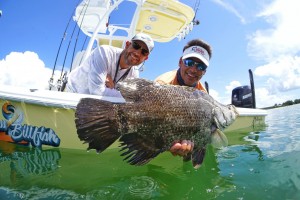
Atlantic tripletail are like tropical nomads. With a definitively unique appearance and behavior, these animals spend their lives on the surface of the water column. They aren’t particularly boat shy, yet are still a challenge to find and entice to eat. Similar to dolphin, tripletail can be found by locating floating debris and weedlines. Here in Florida, these fish provide great opportunity in both the Gulf of Mexico and Atlantic waters…both inshore and offshore. If you’re a seafood lover, you’re in for a delicious surprise…tripletail provide stellar table fare, comparable to grouper. Here is the how-to on fishing for Florida tripletail.
Tripletail received their name for obvious reasons. Their dorsal and anal fin extend far back on their body, and appear to be attached to the fish’s tail. Tripletail resemble freshwater crappie-with a sloping forehead and small forward facing eyes. Coloring on these fish is highly dependent on water color and their surroundings. They can range from a mottled dark brown or blackish, to a yellow tint, or a mixture of all three. Tripletail camouflage themselves in order to ambush and stalk their prey. They’ll often float on their side-just beneath the surface, resembling a floating trash bag or a mangrove leaf. My first time seeing a tripletail floating on it’s side; it was motionless with a pale yellow color. I thought the fish was sick or dying…I have since learned this is typical behavior for this species.
For tackle, a medium class 7 foot rod and a 3000 size reel loaded with 10-15 lb. test will suit most tripletail fishing perfectly. However if you are fishing heavy structure, beef up your tackle to pull stubborn fish away from debris. Tripletail are clever, scrappy and will do their best to foul your line. That being said-20-30 lb. fluorocarbon is a good choice. Use a number #4 hook with a shrimp, crab or small baitfish. Tripletail are not picky. Also, ¼ to ½ oz bucktail jigs, or a D.O.A. shrimp are great artificials to try. Tripletail will also willingly take a fly. A 6 or 7 weight rod will fit the bill. Any shrimp or crab pattern, or a white and green streamer can work.
Offshore in both the Gulf and the Atlantic ; tripletail can be found hovering around weed lines or debris. The longer a piece of debris has been floating in the water, the more likely fish will be present. Algae growth on flotsam will draw in the entire food chain. In inshore waters in Southwest Florida; October 15th marks the beginning of stone crab season. Crabbers set out thousands of pots that will stay put until May 15th. Again, the longer the crab buoys soak, the more likely there are to be tripletail on them. Fishing the crab buoys takes patience and persistence, not every buoy will hold fish. When fishing buoy lines-run past the buoys on a plane, but slow enough to spot fish. If you spot a tripletail, drive past the buoy. Don’t pull back the throttle right on top of the fish. Idle or use a trolling motor to slowly make your way back to the buoy. Try to let your offering drift naturally.. If that does not work, drop it right on their nose.
During the spring and fall, Cape Canaveral in the Florida Space Coast holds the title for sheer numbers of big tripletail. Anglers here fish the sargassum weeds and buoy lines. When the fish are in the sargassum, light tackle or fly fishing works wonders and will provide great sport. When the fish are holding on buoys, heavy braided lines gives you with added security. Near Cape Canaveral, fish average under 10 lbs. but there’s a great chance you might have a shot at a 15-20 lb. beast.
Recently, I fished out of South Seas Island Resort in Captiva Island with Capt. Ozzie Fischer. Running the beaches, we came across multiple tripletail floating sideways along swim buoys. We used my trolling motor to idle to the fish from down current and pitched weightless, small pilchards with great success. For one fish, a 12 lber that had spooked and dived-a small split shot placed right above the hook was the ticket for getting a bite. Again, patience and persistence is key. Devote some time to each fish and mix it up with your fishing style, using baits or lures. If it’s just not happening-return to that fish later on, after they have settled down. Tripletail will not stray far from the structure they are holding on.
If you decide to keep some tripletail for the dinner table, Florida regulations in both Gulf and Atlantic state waters put a minimum size limit of 15’’ and a daily bag limit of 2 fish per person. Tripletail provide some of the best table fare of any of the species we catch. However, they can be difficult to clean, with giant scales that act like armor. A long sharp knife is key. In between fish-make sure to sharpen your blade. Here’s the process: press down hard with your blade and make a clean cut from the top of the head, in back of the pectoral fin, down to the gut. Run your blade down the back, and then along the bottom of the fish. Now make long strokes, slicing the fillet away from the backbone. Remember to take your time! When cooking tripletail, the less preparation the better. Tripletail fillets are white, flaky and mild…best suited to being sautéing quickly or broiled.
